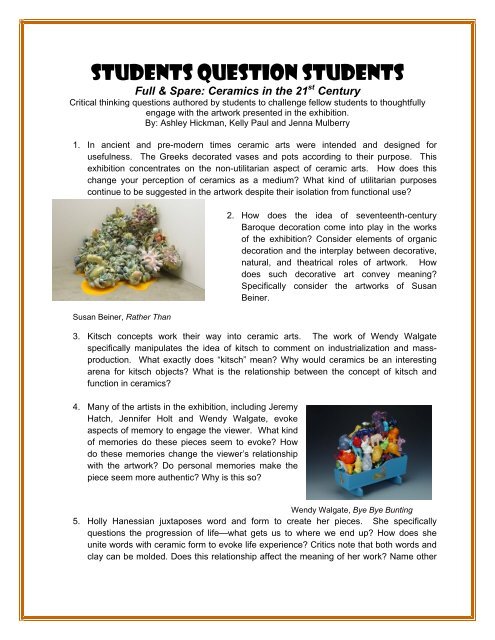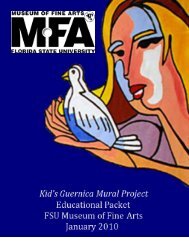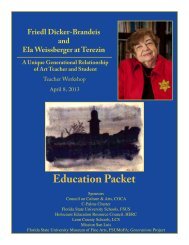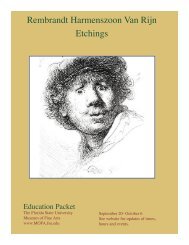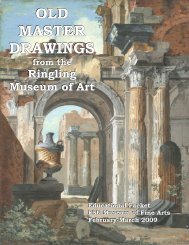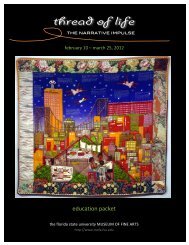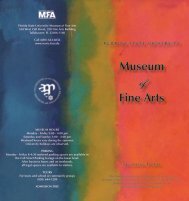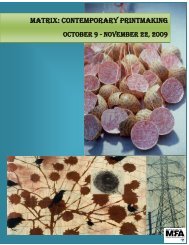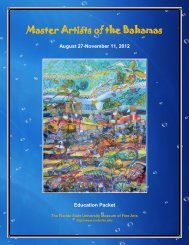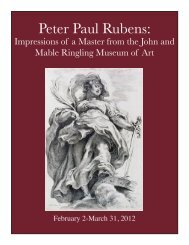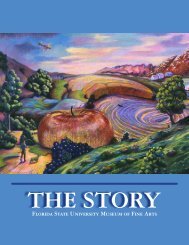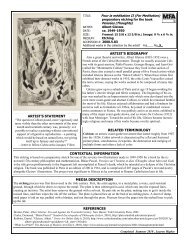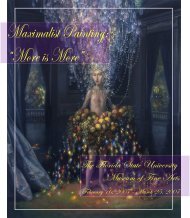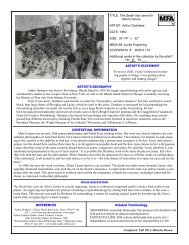a printable PDF
a printable PDF
a printable PDF
Create successful ePaper yourself
Turn your PDF publications into a flip-book with our unique Google optimized e-Paper software.
Students Question StudentsFull & Spare: Ceramics in the 21 st CenturyCritical thinking questions authored by students to challenge fellow students to thoughtfullyengage with the artwork presented in the exhibition.By: Ashley Hickman, Kelly Paul and Jenna Mulberry1. In ancient and pre-modern times ceramic arts were intended and designed forusefulness. The Greeks decorated vases and pots according to their purpose. Thisexhibition concentrates on the non-utilitarian aspect of ceramic arts. How does thischange your perception of ceramics as a medium? What kind of utilitarian purposescontinue to be suggested in the artwork despite their isolation from functional use?Susan Beiner, Rather Than2. How does the idea of seventeenth-centuryBaroque decoration come into play in the worksof the exhibition? Consider elements of organicdecoration and the interplay between decorative,natural, and theatrical roles of artwork. Howdoes such decorative art convey meaning?Specifically consider the artworks of SusanBeiner.3. Kitsch concepts work their way into ceramic arts. The work of Wendy Walgatespecifically manipulates the idea of kitsch to comment on industrialization and massproduction.What exactly does “kitsch” mean? Why would ceramics be an interestingarena for kitsch objects? What is the relationship between the concept of kitsch andfunction in ceramics?4. Many of the artists in the exhibition, including JeremyHatch, Jennifer Holt and Wendy Walgate, evokeaspects of memory to engage the viewer. What kindof memories do these pieces seem to evoke? Howdo these memories change the viewer’s relationshipwith the artwork? Do personal memories make thepiece seem more authentic? Why is this so?Wendy Walgate, Bye Bye Bunting5. Holly Hanessian juxtaposes word and form to create her pieces. She specificallyquestions the progression of life—what gets us to where we end up? How does sheunite words with ceramic form to evoke life experience? Critics note that both words andclay can be molded. Does this relationship affect the meaning of her work? Name other
ways Hanessian shows the multiplicity of meaning in the relationship between words andher forms?6. In her work, Annabeth Rosen explores the Japanese idea of letting the materials (clayand glazes) speak to her throughout her artistic process. This yields works that seem toshow little artistic intervention on her part. How is this idea revealed in her work?Determine the individual characteristics of her various pieces? How might thesecharacteristics relate to the original state of the materials?piece?7. Jeanne Quinn states that people in Medievaltimes believed in a perfect world of symmetry.She creates contemporary, monumental, butdelicate, installations that seem to gounnoticed at first but then capture the viewersattention upon visual recognition. How doesher work reflect the medieval and thecontemporary? What kind of symmetry doesshe use? How does the moment of visualrecognition alter the original perception of theJeanne Quinn, Where I Live This is What the Sky Looks Like8. The conception of industrialized yet organic and often hybridized forms, specifically inrelation with their natural counterparts, becomes a point of interest for several of theartists including Nancy Blum, Cynthia Giachetti, and Ying-Yueh Chuang. How does thejuxtaposition of hybrid forms with organic forms create both tension and harmony in theceramic pieces of these artists? What about the combination of two different types oforganic forms—terrestrial and aquatic? Do these pieces still seem familiar to theviewer? What does this familiarity say about the affect of artificial production andcombination on society today?9. In his work, Jason Briggs creates pieces that challenge the viewer to search for newmeaning. But Briggs expects the viewer to begin building that meaning from personalknowledge. Briggs wants viewers to explore his objects with a child-like openness. Howdoes this approach affect the viewer’s relationship with the artwork? Do viewers alwaysbring preconceptions to each piece they encounter?10. In Julie York’s work she focuses on the dichotomy between absolute and abstract,specifically concentrating on how perceptions can be distorted. What kind of familiarforms can be derived from her pieces? How does she manipulate these forms tochallenge her viewer?


